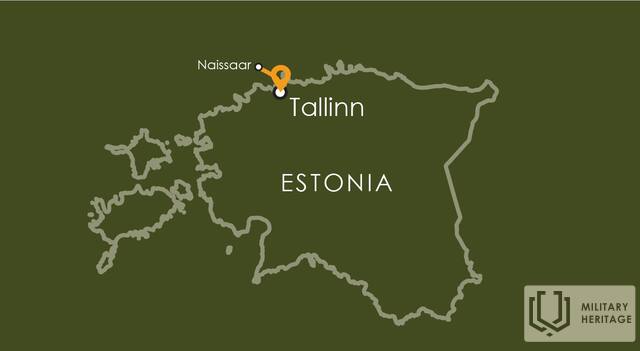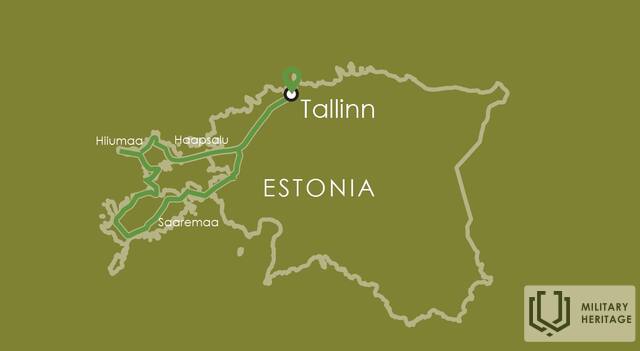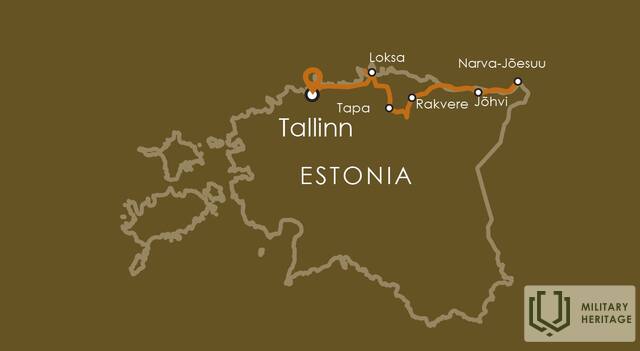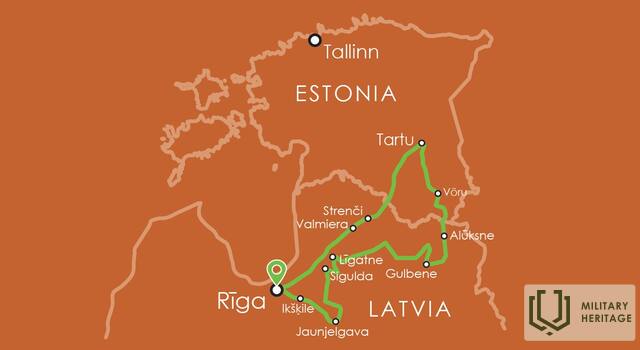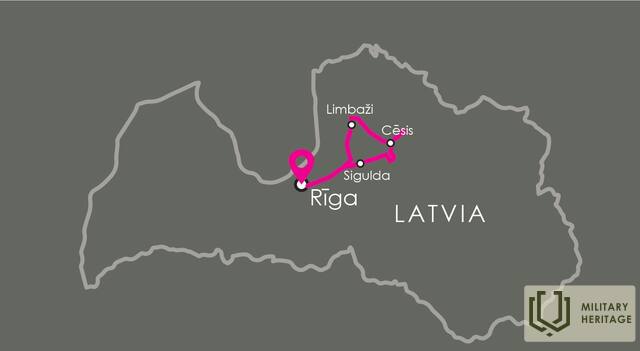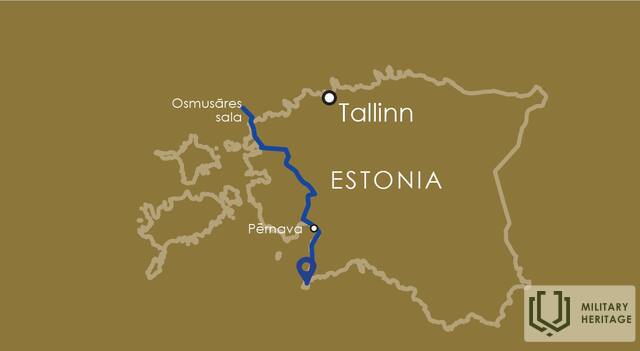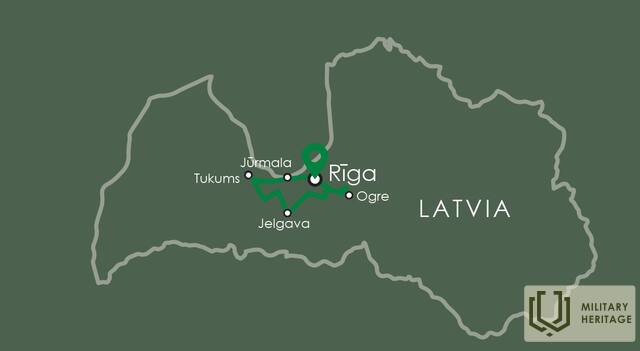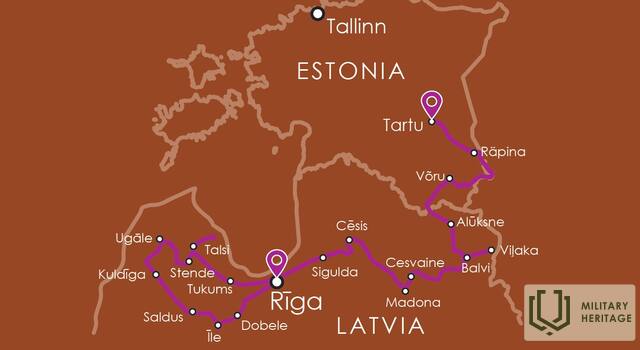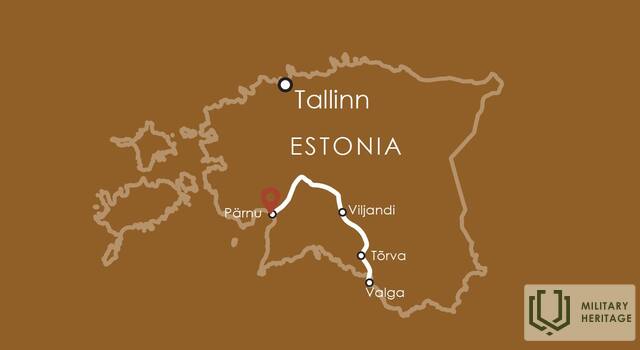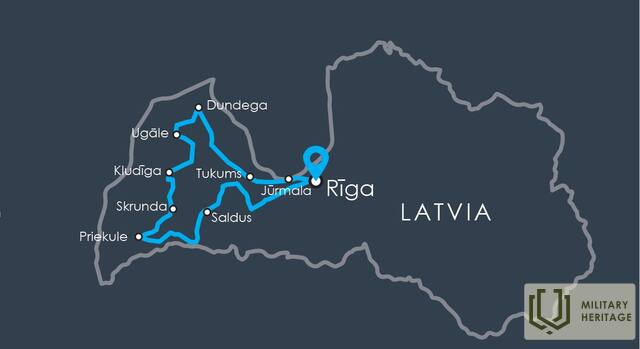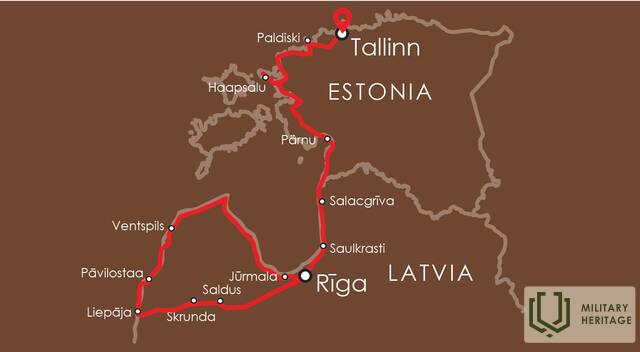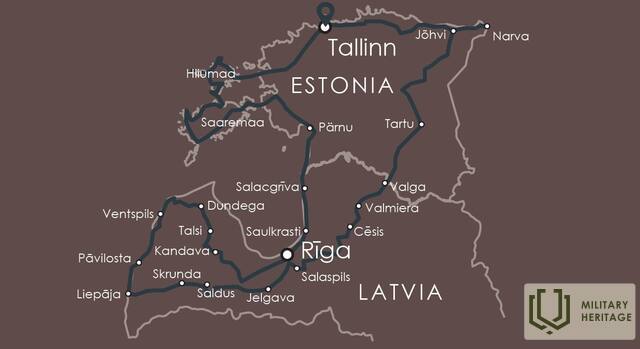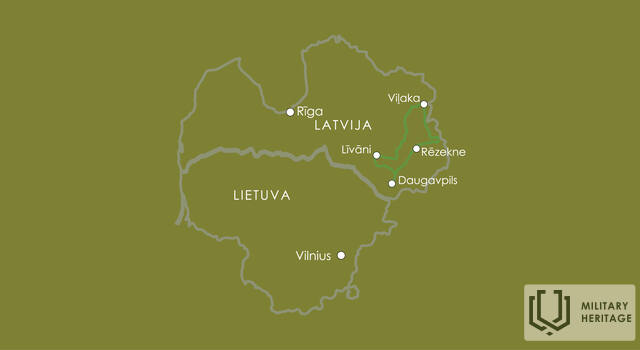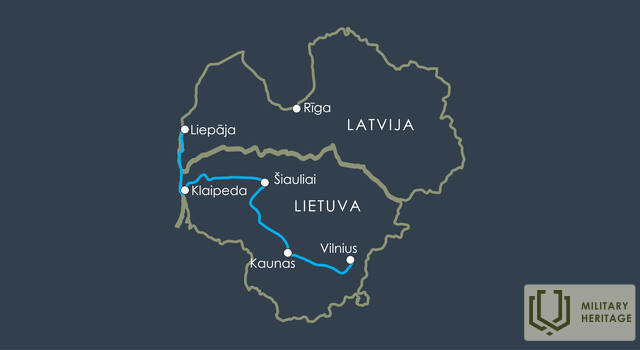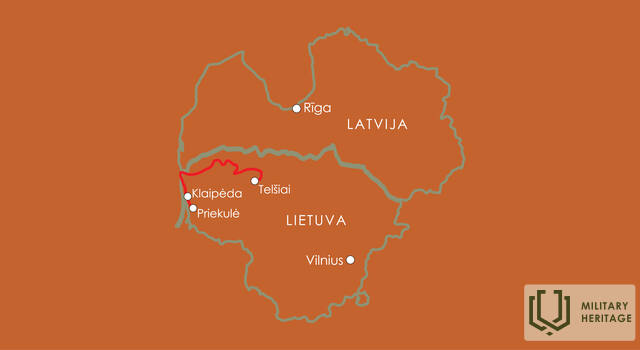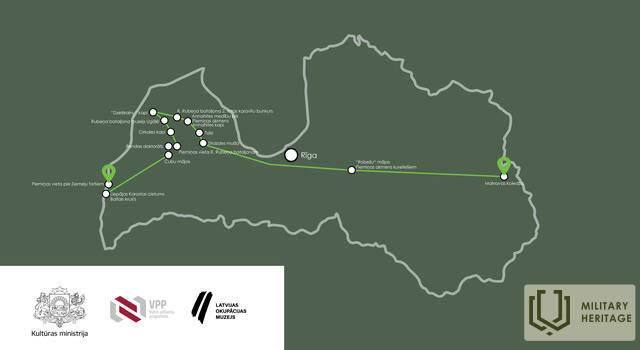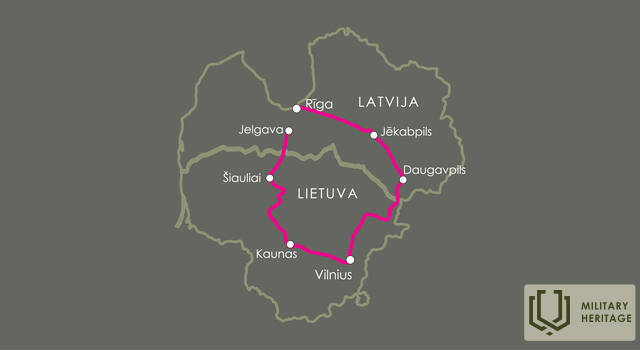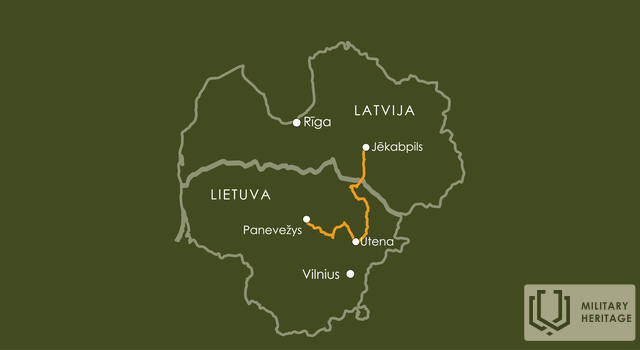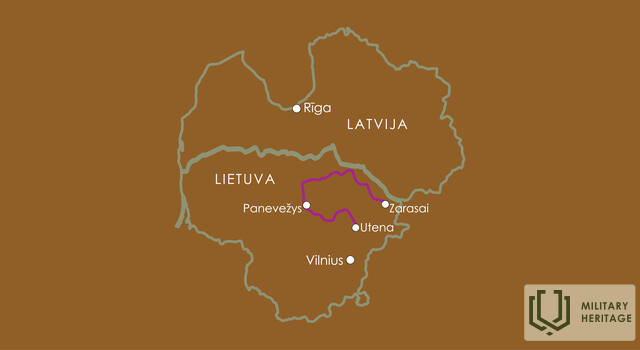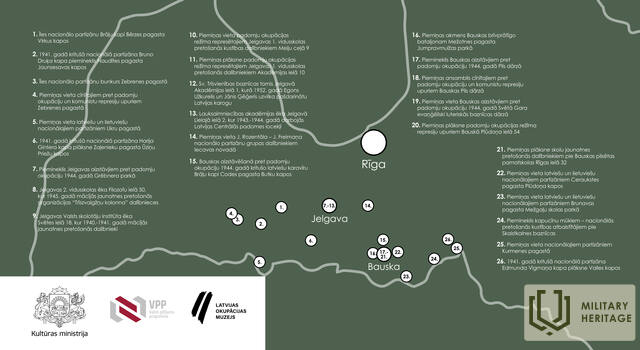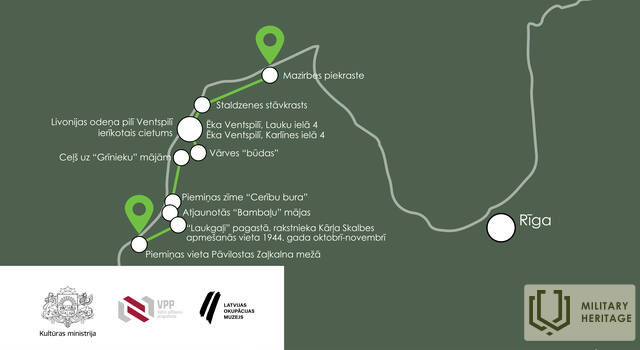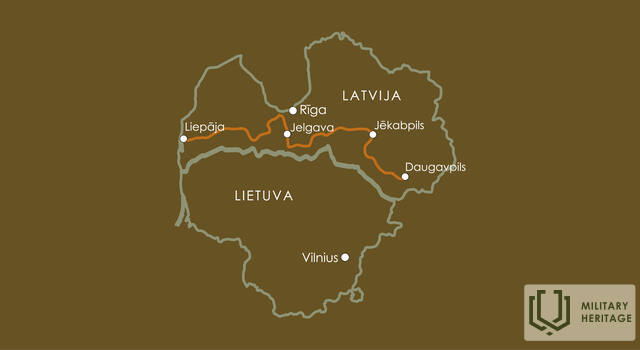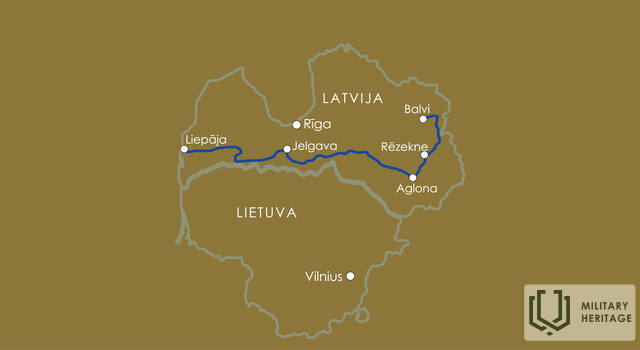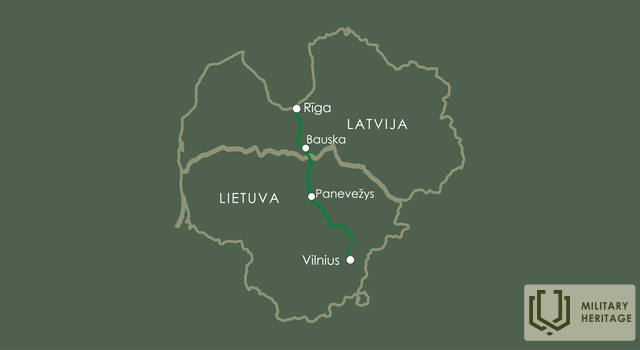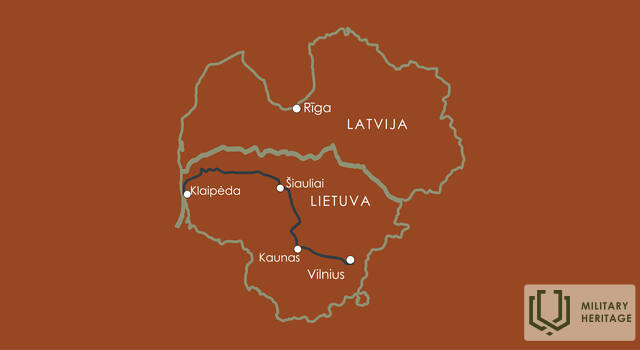Sõjaajaloo pärandi ringreisid
Külastajate jaoks on koostatud sõjaajaloo pärandiga seotud paikadesse viivad marsruudid, mis on kirjeldatud päevateekondade kaupa. Lisaks on välja toodud soovitused majutus- ja söögikohtade osas, mis asuvad marsruudil või selle läheduses.
Iga objekti juures leiab kontaktid, kust saab otsida teavet reisi planeerimiseks nagu soovitud külastusaeg, infokeskuseid jne. Igat marsruuti saab kohandada vastavalt enda soovidele. Samuti on võimalik kasutada kaarti ning objekti kohta koostatud infot lahtiolekuaegade jne kohta. See võimaldab planeerida piisavalt aega sõitmiseks, muuseumite jm objektide külastusteks ning majutuseks.
Marsruuti planeerides soovitame otsida võimalikult palju infot juba enne reisi, nt lahtiolekuajad, pakutavad teenused, giidituurid jms.
Elu Eestis Nõukogude okupatsiooni ajal
Ringreis viib külastajad tutvuma Tallinna lähedal asuvate sõjaajalooliste objektide ning muuseumidega, mis tutvustavad Eesti territooriumil toimunud sõjasündmusi erinevatel ajaperioodidel ning Nõukogude okupatsiooni aega Eestis.
Saaremaa ja Hiiumaa – Eesti merepiiri valvurid
Eesti suursaared Saaremaa ja Hiiumaa asuvad Eesti läänepiiril. Püüdlused saarte rannakaitse infrastruktuuri rajamiseks ja täiustamiseks on kestnud läbi aegade. Lahingud suursaartel erinevate vägede vahel toimusid nii I kui ka II maailmasõja ajal. Metsavennad tegutsesid Hiiumaal ka pärast sõda.
Nõukogude armee okupeeritud Eesti territooriumil
Ringreisil saab tutvuda sõjaajalooliste objektidega ja varasemalt suletud olnud piirkondadega sõites läbi Lahemaa rahvuspargi, Rakvere linna ja piirilinna Narva.
Nõukogude okupatsiooni pärand Põhja-Vidzemes ja Lõuna-Eestis
Ringreis tutvustab Nõukogude armee ja KGB (Riikliku Julgeoleku Komitee) tegevust 50 aastat kestnud Nõukogude okupatsiooni ajal Lätis ja Eestis. Sel ajal ehitati ja anti käiku sõjaväebaase, salajasi sõjaväerajatisi ja lennuvälju ning rajati suletud sõjaväeterritooriume. KGB pani proovile riigi elanike lojaalsuse nõukogude režiimile ning selle vastased hävitati moraalselt ja füüsiliselt.
Võnnu (Cēsise) lahingute jälgedes
Ringreis tutvustab 1919. aasta Cēsise (Võnnu) lahingute sündmusi, mil Läti Ajutise Valitsuse relvajõud alistasid koos Eesti sõjaväega Saksa Landeswehri ja Rauddiviisi üksused. Eesti sõjaajaloos on need lahingud tuntud kui Landeswehri sõda. Cēsise (Võnnu) lahingud oli üks Läti Vabadussõjas võtmesündmusi 18. novembril 1918 välja kuulutatud Läti riigi iseseisvuse kaitsmisel.
Relvastatud vastupanu Nõukogude okupatsioonivõimule Sēlias
Marsruudil saate teada Sēlias Nõukogude okupatsioonirežiimi vastase relvastatud vastupanuliikumise tõenditest, rahvuslike partisanide punkrite asukohtadest, külastate lahingu- ja mälestuspaiku ning saate teada partisanide ja nende toetajate memuaaridest.
Vabadussõja radadel Lääne-Eestis
Pärnu- ja Läänemaa asuvad Eesti läänerannikul. Osmussaar on 4,8 km2 suurune saar Soome lahe suudmes, mida kasutati sõjaväe eelpostina. Pärast II maailmasõda asus saarel Nõukogude armee üksus ja sellest sai suletud militaartsoon.
Esimene maailmasõda ja Jõululahingud Riia piirkonnas
Ringreisil külastatakse Jõululahingutega seotud paiku, näiteks Läti küttide rünnakukohta Saksa armee üksuste vastu 1916. aasta eriti karmides talveoludes. Jõululahinguid peetakse Läti ajaloo kõige tuntumaks ja dramaatilisemaks sündmuseks I maailmasõjas.
Metsavendade jälgedes Lätis ja Eestis
Nõukogude okupatsiooni ajal, II maailmasõjas ja vahetult pärast sõda ei leppinud paljud lätlased ega eestlased eluga okupatsioonirežiimi all ning soovisid taastada oma riigi iseseisvuse. Varjuti metsa, elati enda ehitatud punkrites ja korraldati rünnakuid Nõukogude repressiivvõimude vastu. Loodeti, et lääneriigid ei aktsepteeri Nõukogude okupatsiooni ning Läti ja Eesti on peagi taas iseseisvad. Metsavennad jätkasid lahinguid kuni 1950. aastate lõpuni.
Eesti Vabadussõja jälgedes
Ringreisil saab näha Eesti Vabadussõja sündmustega seotud paiku alates Pärnust kuni piirilinna Valgani. Eesti Vabadussõda peeti aastatel 1918–1920.
“Kuramaa koti“ lahinguväljadelt nõukogude pärandiga seotud seiklusteni Dundagas
Ringreisi sihtkohad on II maailmasõja lõpu (oktoober 1944 - mai 1945) sündmustega seotud paigad. Sel ajal taganes Saksa armee Riiast Kuramaale, kus toimus 6 suuremat lahingut Kuramaa rinde eri osades. Ägedate lahingute tõttu on see periood tuntud kui Kuramaa kott või Kura kott. Punaarmee ei suutnud Kuramaad vallutada kuni natsi-Saksamaa kapituleerumiseni.
Mööda raudse eesriide sõjaajaloo pärandi teid Tallinnast Liepajasse
Läänemere rannik oli nõukogude ajal riigi läänepiiriks. NSV Liidu ja lääneriikide vahelist piiri tunti raudse eesriide nime all, kuna selle ülesanne oli isoleerida NSVL-i elanikud muust maailmast. Sõjaväebaaside, rannavalvetornide ja patareidega suleti suurem osa Läti ja Eesti rannikust. Kohalikud elanikud vajasid piirkonnast lahkumiseks või sinna sisenemiseks erilubasid. Vaatamata rangetele kontrollimeetmetele üritati aeg-ajalt piiri ületada ja põgeneda läände.
Suur piiriülene ringreis - Läti ja Eesti 100-aastase iseseisvuse sõjaajalooline pärand
Reisimarsruut tutvustab Eesti ja Läti sõjaajaloo 100-aastast perioodi alates I Maailmasõjast kuni tänapäevani. Keskendutakse mõlema riigi sünnile I Maailmasõja lõpus, kuidas kaitsti enda olemasolu Vabadussõdades, kuidas mõlemad riigid kadusid maailmakaardilt II Maailmasõja käigus, miks metsavennad võitlesid nõukogude okupatsiooni vastu rohkem kui kümme aastat peale sõja lõppu ning kuidas iseseisvus taastati peale viiskümmend aastat kestnud okupatsiooni.
Latgale – Läti idapiir
Latgale on Läti, Balti riikide ja Euroopa Liidu idapiiriala. Ajalooliselt on Latgale olnud mitmesuguste ajaloosündmuste ja territooriumide ristumiskohas. Seda ei säästnud ei 20. sajandi kaks maailmasõda ega ka viimasele sõjale järgnenud Nõukogude okupatsiooni periood. Marsruut pakub laia valikut sõjalisi pärandpaiku, kus on objekte 20. sajandi sõjaajaloo kõikidest perioodidest, samuti võimalust õppida rohkem riigipiiride loomise ja kaitsmise kohta nii ajalooliselt kui ka tänapäeval. Seda marsruuti või selle osa saab ühendada järgmiste marsruutidega Leedus: „ Partisanide teed ja rajad Aukštaitias “, „ Läti ja Leedu rahvuspartisanide – metsavendade – lahingupaigad “.
Sõjapärand raudse eesriide ääres
Balti riigid olid Nõukogude Liidu läänepoolseim piir Nõukogude Liidu ajal ja külma sõja ajal. Piiri taga asus see, mida Nõukogude propaganda nimetas „mädanenud lääneks“. NSV Liidu piire valvati hoolikalt, et takistada Nõukogude rahval näha ja kogeda, milline oli elu NSV Liidu piirist läänes elavatel inimestel. Isegi individuaalne kalapüük Läänemerel oli keelatud hirmust, et inimesed põgenevad paatidega üle Läänemere Rootsi. See oli aeg, mil Balti riigid asusid nn raudse eesriide taga asuval territooriumil, mida said ületada vaid „vähed väljavalitud“, kes olid sageli režiimile lähedased isikud. Kui totalitaarne Nõukogude režiim kokku varises, varises kokku ka raudne eesriie. Kuigi marsruudi peateemaks on Teine maailmasõda ja selle tagajärjed – Nõukogude okupatsioon, külm sõda ja raudne eesriie –, hõlmab see ka 20. sajandi teiste sõjaliste perioodide ja tänapäeva paiku. See on samanimelise marsruudi jätk, mis algab Tallinnast ja kulgeb mööda Eesti ja Läti rannikut: „ Sõjapärand raudse eesriide ääres. Autoga marsruut Tallinnast Liepājasse “. Seda marsruuti või selle osi saab ühendada järgmiste marsruutidega Lätis ja Leedus: „ Nõukogude Leedu stseenid “, „ Külma sõja ja Nõukogude okupatsiooni pärand Žemaitijas “, „ Esimene maailmasõda ja vabadussõjad Lõuna-Lätis “, „ Balti tee ääres Vilniusest Riiani “, „ Teine maailmasõda ja selle tagajärjed – Nõukogude okupatsioon Lõuna-Lätis ja Latgales “.
Külma sõja ja Nõukogude okupatsiooni pärand Žemaitijas
See marsruut uurib Nõukogude võimu ja külma sõja pärandit. Teise maailmasõja ajal, pärast Saksa okupatsiooni, naasis Nõukogude võim teist korda Leetu. Leedu ei eksisteerinud sel perioodil iseseisva riigina, kuna see liideti NSV Liiduga. Algas vastupanu okupatsioonirežiimile ja Nõukogude Liidu ulatuslikud küüditamisoperatsioonid. Külma sõja võidurelvastumisel paigutas Nõukogude valitsus Leetu ka oma tuumarelvad. Marsruut hõlmab ka mõningaid 20. sajandi sõjaajaloo teistesse perioodidesse kuuluvaid paiku. Seda marsruuti või selle osa saab ühendada järgmiste marsruutidega Lätis: „ Teine maailmasõda ja selle tagajärjed – Nõukogude okupatsioon Lõuna-Lätis ja Latgales “, „ Esimene maailmasõda ja vabadussõjad Lõuna-Lätis “.
Kurelis: Läti eest võõrvõimude vastu okupatsioonivõimude vastu
Marsruudi jooksul saate teada Nõukogude ja Saksa okupatsioonirežiimide vastase vastupanuliikumise tõenditest, autentselt rekonstrueeritud rahvuspartisanide punkrite kohta ning külastate hoolitsetud asulaid, lahingupaiku ja mälestuspaiku. Kurelaste mälestustest saate teada audiogiidi abil, kohalike ajalooekspertide lugusid ja teil on võimalus ööbida rubenlaste punkris.
Suur piiriülene marsruut – Läti ja Leedu sõjapärand 100 aasta jooksul
Marsruut ühendab kahte pealinna – Riiat ja Vilniust – ning kahte suuremat linna väljaspool Leedu ja Läti pealinnu – Kaunast ja Daugavpilsi – läbides viit ajaloolist piirkonda. Marsruudil võite külastada kõige olulisemaid sõjaväeobjekte, mis annavad tunnistust eelmise sajandi ja käesoleva sajandi alguse ajaloosündmustest. See on jätk marsruudile „ Suur piiriülene marsruut – Läti ja Eesti sõjapärand üle 100 aasta “, mis hõlmab Eestit ja Lätit (Vidzeme, Kuramaa). Seda marsruuti või selle osi saab ühendada järgmiste marsruutidega Lätis ja Leedus: „ Sõjapärand raudse eesriide ääres “, „ Nõukogude Leedu stseenid “, „ Esimene maailmasõda ja vabadussõjad Lõuna-Lätis “, „ Läti ja Leedu rahvuspartisanide – metsavendade – lahingupaigad “, „ Teine maailmasõda ja selle tagajärjed – Nõukogude okupatsioon Lõuna-Lätis ja Latgales “, „ Partisanide teed ja rajad Aukštaitias “, „ Latgale – Läti idapiir “.
Läti ja Leedu rahvuspartisanide – metsavendade – lahingupaigad
Marsruudi teema keskendub rahvuspartisanidele, kes panid vastu Nõukogude okupatsioonile ja püüdsid taastada iseseisvust. Partisane kutsuti metsavendadeks, sest partisanide rühmad elasid metsades ja soodes asuvates punkrites ning korraldasid rünnakuid okupatsioonivõimude vastu. Partisanid elasid punkrites veel pikka aega pärast Teise maailmasõja lõppu. Marsruut hõlmab rahvuspartisanide lahingupaiku, matmispaiku ja mälestuspaiku Kagu-Lätis ja Kirde-Leedus. Seda marsruuti või selle osi saab ühendada järgmiste marsruutide või nende osadega Lätis ja Leedus: „ Mööda Balti teed Vilniusest Riiga “, „ Partisanide teed ja rajad Aukštaitias “, „ Nõukogude Leedu vaated “, „ Latgale – Läti idapiir “, „ Esimene maailmasõda ja vabadussõjad Lõuna-Lätis “, „ Teine maailmasõda ja selle tagajärjed – Nõukogude okupatsioon Lõuna-Lätis ja Latgales “, „ Suur piiriülene marsruut – Läti ja Leedu sõjapärand üle 100 aasta “.
Partisanide teed ja rajad Aukštaitijas
Marsruut tutvustab rahvuspartisanide tegevust Leedus. Nõukogude okupatsiooni ajal peeti partisanisõda, mille käigus jagati Leedu territoorium üheksaks partisanipiirkonnaks. Leedu rahvuspartisanid olid hästi organiseeritud ja relvastatud, kandsid sõjaväevormi ja jätkasid sõdadevahelise perioodi Leedu armee traditsioone. Nad võitlesid mõrvarlike NKVD (Nõukogude salapolitsei) ja Punaarmee üksustega ning valmistasid ette rünnakuplaane. Tagakiusamise ja uteliailta pilkude eest varjates ehitasid Leedu partisanid endale metsade ja soode tihnikutesse punkreid. Marsruut hõlmab ka mõningaid 20. sajandi sõjaajaloo teistesse perioodidesse kuuluvaid paiku. Seda marsruuti või selle osa saab ühendada järgmiste marsruutidega Lätis: „ Latgale – Läti idapiir “, „ Teine maailmasõda ja selle tagajärjed – Nõukogude okupatsioon Lõuna-Lätis ja Latgales “, „ Esimene maailmasõda ja vabadussõjad Lõuna-Lätis “, „ Vastupanu Nõukogude okupatsioonirežiimile Zemgales“ .
Vastupanu Nõukogude okupatsioonirežiimile Zemgales
Marsruudil saate teada Zemgale Nõukogude okupatsioonirežiimi vastase relvastatud ja vägivallatu vastupanuliikumise tõenditest, koolinoorte ja rahvuspartisanide tegevusest ja mälestuspaikadest ning tutvuda vastupanuliikumises osalejate ja nende toetajate mälestustega.
Põgenike paadid Kuramaa rannikult Rootsi
Läti Kesknõukogu ventspilsi kommunikatsioonigrupi tegevused ja mälestuspaigad, mis on pühendatud salajastele põgenike paadioperatsioonidele Kuramaa rannikult Rootsi Gotlandile.
Esimene maailmasõda ja Vabadussõjad Lõuna-Lätis
Marsruut läbib Läti lõunaosa, lähenedes Leedu piirile, ja ulatub äärmisest lääneosast – Liepājast – kagusse – Daugavpilsini, mis on Läti suuruselt teine linn. Marsruudi teemaks on Esimene maailmasõda ja sellele järgnenud Läti Vabadussõda. Seda marsruuti või selle osa saab ühendada järgmiste marsruutidega Leedus: „ Külma sõja ja Nõukogude okupatsiooni pärand Žemaitijas “, „ Nõukogude Leedu stseenid “ või „ Sõjaline pärand raudse eesriide ääres “.
Teine maailmasõda ja selle tagajärjed – Nõukogude okupatsioon Lõuna-Lätis ja Latgales
Marsruut kulgeb läbi Läti lõunaosa mööda Leedu piiri ning pöörab seejärel mööda Euroopa Liidu piiri – läbi Latgale Balvi suunas. See ühendab Läti kahte kõige kaugemat punkti – Liepājat Läti edelaosas ja Balvit riigi kirdeosas, esitades Teise maailmasõja tõendeid nii Kuramaa taskus kui ka Ida-Lätis. Marsruut paljastab ka sõja tagajärjed – Nõukogude okupatsiooni ja selle raske mõju 20. sajandi inimeste saatusele. Seda marsruuti või selle osa saab ühendada järgmiste marsruutidega Leedus: „ Külma sõja ja Nõukogude okupatsiooni pärand Žemaitijas “, „ Nõukogude Leedu stseenid “ või „ Sõjaline pärand raudse eesriide ääres “.
Balti tee ääres Vilniusest Riiga
Marsruut järgib nn Balti keti koridori. Balti kett toimus 23. augustil 1989 umbes kell 19.00, kui kaks miljonit inimest kolmes Balti riigis moodustasid 15 minutiks kätest kinni hoides umbes 670 km pikkuse elava keti, mis ühendas kolme Balti riigi pealinna – Vilniust, Riiat ja Tallinna. Marsruut hõlmab ka mõningaid 20. sajandi sõjaajaloo teistesse perioodidesse kuuluvaid paiku. Seda marsruuti või selle osi saab ühendada järgmiste marsruutidega Lätis ja Leedus: „ Sõjapärand raudse eesriide ääres “, „ Nõukogude Leedu stseenid “, „ Esimene maailmasõda ja vabadussõjad Lõuna-Lätis “, „ Läti ja Leedu rahvuspartisanide – metsavendade – lahingute paigad “, „ Teine maailmasõda ja selle tagajärjed – Nõukogude okupatsioon Lõuna-Lätis ja Latgales “ ning „ Vastupanu Nõukogude okupatsioonirežiimile Zemgales “.
Nõukogude Leedu stseenid
Marsruut võimaldab ränduril mõista Nõukogude okupatsiooni ulatust ja selle jälgi Leedu ajalukku, paljastades samal ajal inimeste võime säilitada oma identiteeti ja võidelda iseseisvuse eest. Nõukogude okupatsioon Leedus kestis umbes viis aastakümmet. Teisele maailmasõjale järgnesid Nõukogude repressioonid, rahvuslike partisanide vastupanu, Leedu militariseerimine külma sõja ajal ja Leedu iseseisvuse taastamine. Leedu oli NSV Liidule strateegiliselt oluline ka oma läheduse tõttu lääneriikidele, mistõttu sinna paigutati sõjaväeobjekte. Marsruut hõlmab ka mõningaid 20. sajandi sõjaajaloo teistesse perioodidesse kuuluvaid paiku. Seda marsruuti või selle osa saab ühendada järgmiste marsruutidega Lätis: „ Teine maailmasõda ja selle tagajärjed – Nõukogude okupatsioon Lõuna-Lätis ja Latgales “, „ Esimene maailmasõda ja iseseisvussõjad Lõuna-Lätis “.
Ärkamisajast kuni Läti iseseisvuse taastamiseni
Marsruudil tutvute ärkamisaja oluliste sündmuste ja mälestuspaikadega Läti pealinnas Riias ja selle ümbruses, alustades vägivallatu vastupanu ilmingutest Vabadusmonumendi juures 14. juunil 1987 ja lõpetades Läti rahva tahet väljendava riikliku suveräänsuse õigusakti - Läti Vabariigi iseseisvuse taastamise deklaratsiooni - vastuvõtmisega 4. mail 1990 ja Läti Vabariigi riikliku staatuse seaduse - vastuvõtmisega 21. augustil 1991.




